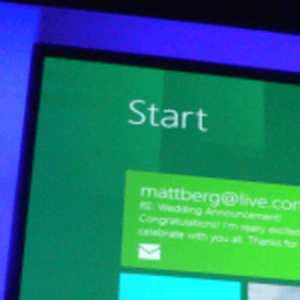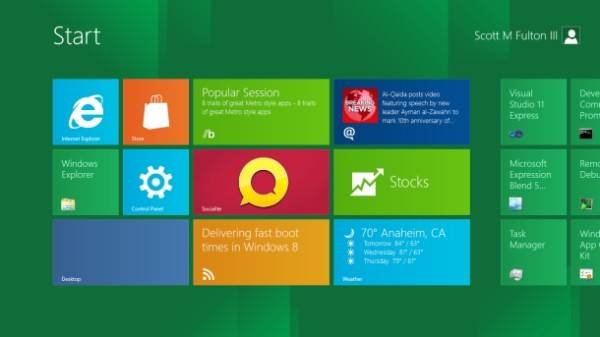The memo has already gone out to the various book editors, news editors and technology analysts: The proper phrase is not “tablet PC” any more. A tablet and a PC are perceived by both consumers and businesses as two separate classes of device. You probably saw the TV ads this season where Santa’s elves kicked out the 4G smartphones and tablets, and dispensed with the old gifts nobody wants. “Bye, bye, computer,” the elves sang to an old Johnny Mathis tune.

Since its very inception, Microsoft’s business model has been about leverage. It uses its established foundation in one popular platform to extend another. The advance of the tablet had been announced further ahead of time than Margaret Thatcher announced the surge on the Falklands. It’s not like Microsoft didn’t see this coming. But in 20/20 hindsight, it’s remarkable to see now how the company appears to have actively worked to thwart that advance, to slow it down, by introducing potential form factors that could deflect interest in tablets – for example, an embedded device that could reveal the weather forecast and present your e-mails, that could be sewn to one’s luggage.

“What Am I?” Round 4
For over a decade, electronics manufacturers looked to Microsoft and Intel for leadership in defining what a handheld, functional form factor would be, because its marketability would need to be fueled by a desirable platform. Their first attempt, called “Origami,” was crude, ungainly, and powerless, even jumping the borderline into the territory of ridiculous; but then amazingly, their second and third attempts were no better.
A tablet PC was not as desirable as a tablet. Consumers were clearly demonstrating a preference for a device that did not remind them of everyday work. Connecting to their PC would be nice, but being another PC was not necessary. Unfortunately for Microsoft, Apple answered that call almost completely. Just as more smartphones today resemble iPhones than BlackBerrys, more tablets today resemble iPads than PCs. Only recently has there been a tablet form factor that any plurality of manufacturers would want to promote as a top-shelf product.
Still, no single manufacturer – not even Apple – has sewn a common thread through every electronics form factor using a substance more solid than branding alone. While parts of the Windows Phone platform are indeed Windows, the two platforms are designed to run different software. The holy grail for Microsoft would be more than a common thread, but a bond of technology that seals the deal for both Windows Phone and Windows 8, creating the need for one out of the need for the other.
The challenges for Microsoft toward this end are these:
1. Making customers want this. The party that stands to benefit the most, and the soonest, from a convergence of “the two Windowses” is comprised of wireless carriers. Their support may be critical, because the massive investment manufacturers require to produce high-bandwidth touchscreen connectivity devices won’t be subsidized by consumers alone. Microsoft’s tying one Windows to the other may be the only factor that sparks carriers’ interest in investing in Windows Phone-capable devices, and in following Microsoft’s more carefully plotted hardware support strategy (letting Microsoft define what the phone should be). But that same value proposition is not obvious to the consumer, who has already divided “tablet” from “PC” in her mind, and so far is quite pleased with the result. And as long as the end customer demonstrates no desire, the carriers won’t generate it either.
2. Creating a common class of software. There is frankly not much software that can, or even should, scale up to fit the PC and then scale down to smartphone size and retain most of its functionality. There’s a way to play “Angry Birds” on a PC, but folks seem to have more fun holding it in their hands. Handheld games are fun because they are handheld. There’s a way to create .DOCX and . XLSX files on a smartphone, but it’s typically a waste of time trying to create an entire database with a mail-merge form on a plane. You can’t just scale software up or down and expect it to be as functional or as practical; anything that should scale must be redesigned for scalability. Redesigning everything to fit a hybridized platform is actually harder, and potentially less successful, than designing something completely new from the ground up.
3. Tying all devices to the same cloud. Conceivably, the most important common bond between devices bearing a Windows logo could be a Microsoft cloud-delivered service. At long last, Windows Live has a purpose that customers can easily embrace: Syncing media between devices is the most obvious and desirable cloud service. But if Microsoft transitions too much of its software into cloud-based services too soon, key components of Windows’ original value proposition would be put in play. For example, many home offices run Windows because they need to run the same Microsoft Office (i.e., not the Mac OS version) that’s in their workplaces. A fully capable Office suite in the cloud may (and most likely will) find itself challenged by other fully capable, cloud-based suites whose cross-platform nature will make Windows dependency seem like a handicap. And PC-centric applications deployed through Windows Azure are already finding themselves challenged by cross-platform apps deployed through Salesforce.com’s Heroku, and probably by new cloud players as well.

*Some assembly required.
So it’s amid these challenges that Microsoft is advancing Windows 8, whose first public beta may be expected in late February. Its value proposition is under construction, but it may be the best that Microsoft can do with what it has. There are asterisks all over its plan.
Windows 8 will run a new class of software*, that takes a cue from how tablets make software unlike the PC by being itself being unlike a PC. This class may (let’s not say “will” just yet, to be safe) be cross-platform*. You’ll still be able to run the existing software (on your PC), but what will make the new software desirable will be 1) its newness; 2) its use of a new and secure* common reference model for software; 3) its connectivity to a cloud* that connects all Windows-branded devices with yet another class of software*.
*The asterisks, of course, all mean, “To be determined (TBD).” It isn’t that Microsoft has this Apple-style curtain over these facts which it will eventually reveal in some gala premiere special with Mariah Carey and Boyz 2 Men. The painfully obvious fact is that no one at all really knows how this convergence will work, and the beta process will literally be a live dress rehearsal for all these ideas.
Microsoft is dictating terms with respect to specifications for Windows Phones, just the way it has done with specs for PCs that qualify to carry the Windows logo. To put itself in a position to do so, and to make the bargain worthwhile for carriers, it alludes to the promise of a common leverage point with the established PC platform, in which customers have already made significant investments. Windows could be more than just synchronized; it could be coordinated, providing what the company calls “the end-to-end experience.” But to make this promise, it has had to upend its entire development strategy for desktop computing, which is based around the .NET Framework upon which the Windows Azure cloud depends – and it’s that same cloud which must somehow tie together the common functions of Windows on PCs, tablet, smartphones, and conceivably HDTVs if they’re still in the mix.
Time warped
All this may make you ask, why didn’t I entitle this article, “Is Windows 8 too early?” The answer lies back with the failed unveiling of the Origami UMPC in 2006. Of all the bad ideas and feature omissions (such as connectivity being a future option) which ended up dooming Intel’s and Microsoft’s joint prototype, the fatal bullet may have been the first one fired anyway: From a distance, you could still see that the UMPC was made to run Windows XP. Not Vista, XP. If these companies had serious intentions on advancing a mobile platform, their failure to even make the attempt to court the industry that already had a lock on mobility – the wireless carriers – was no more clearly demonstrated than with XP on their mobile PC.
Microsoft’s entire business philosophy has been built around extending the PC. And when it ran up against a barrier beyond which the PC operating system and methodology could not be pushed, it pushed anyway. 2006 was Microsoft’s opportunity to reinvent the wheel to fit a new and bolder mechanism. The time for Metro-style apps and accessible cloud services and the minimalist design philosophy was six years ago. But instead of prototyping the Windows Phone that could bridge the two platforms back then when the world was ready for it, beating Apple to the punch, Microsoft spent all its resources and talent on building Zune – a single-function device whose only purpose was to take a bite out of the iPod.
Today, the iPod (with an “o”) isn’t even on anyone’s radar; it’s a relic. Like a greenhorn hunter, Microsoft aimed at where it thought the market was at the time, not where it was going. Windows 8 should have been Windows 6.
[Photo of Origami PC from CES 2006 by Wolfgang Gruener, TG Daily]










